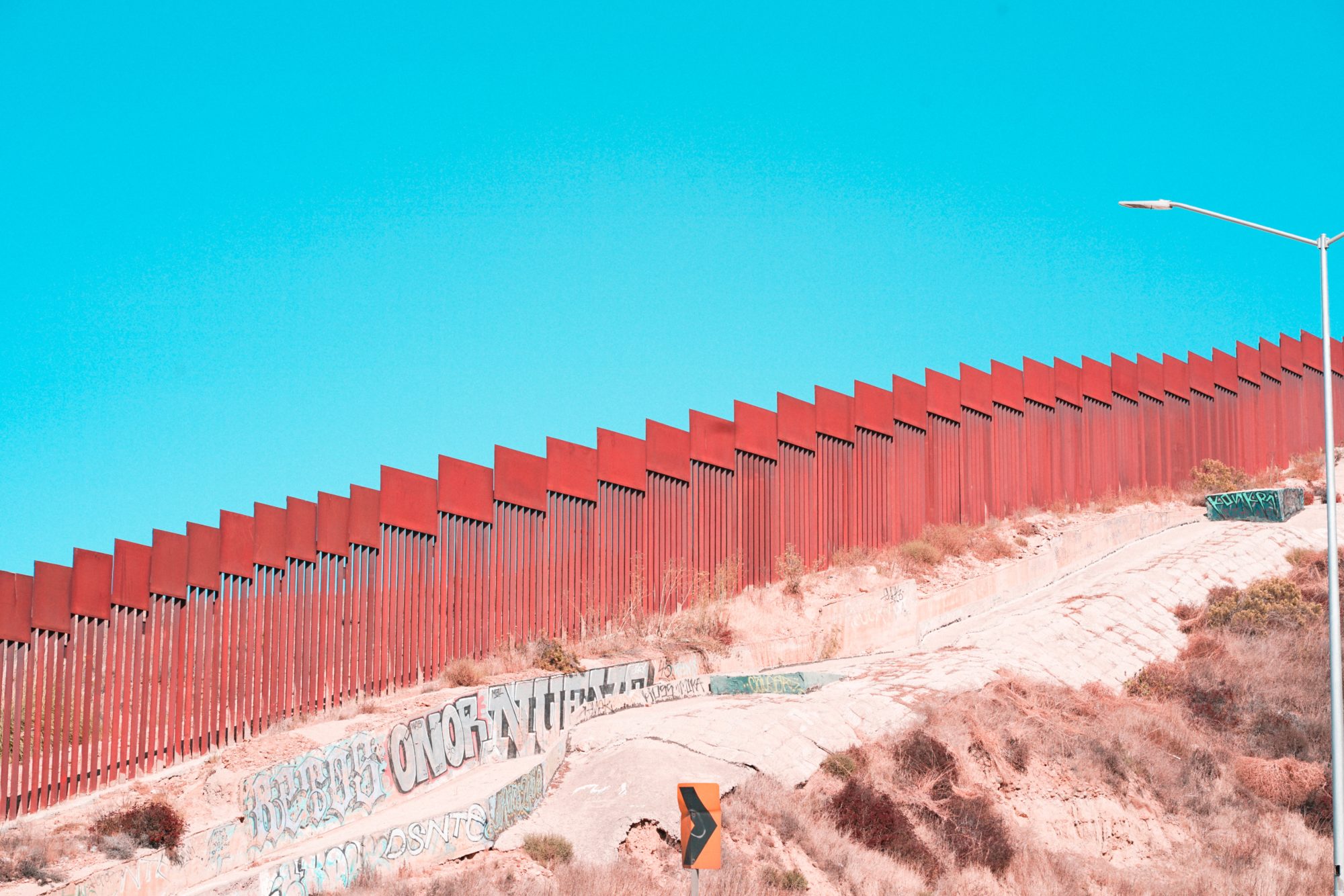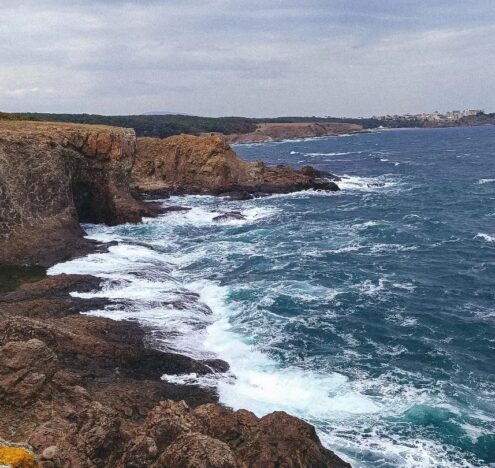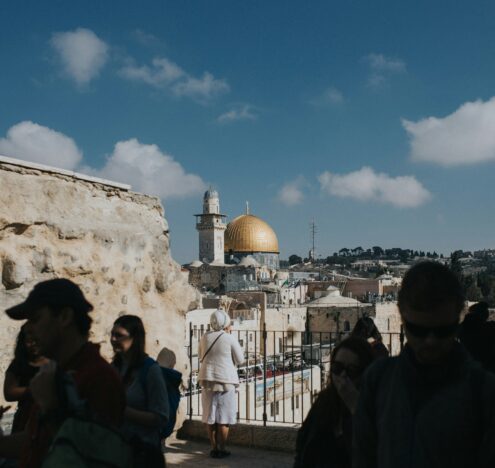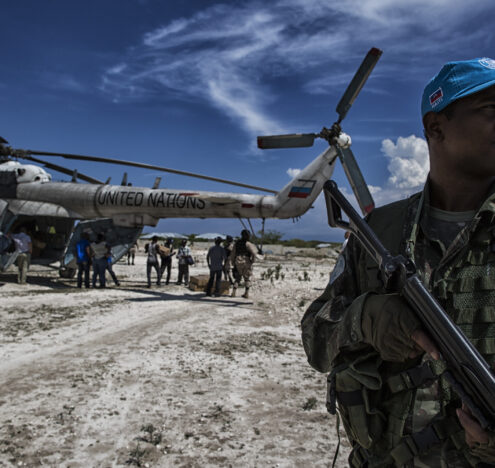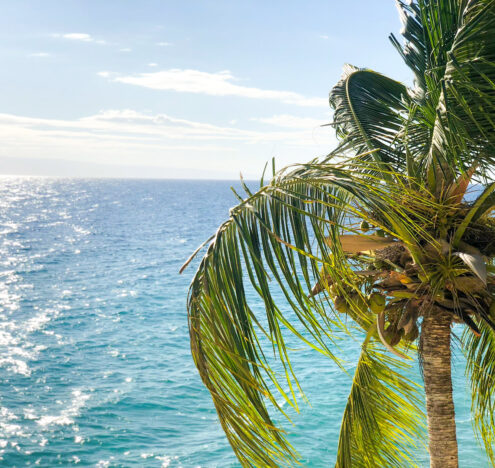From the mountaintops of southern Arizona, you can see a world without borders. I realized this just before I met Juan Carlos. I was about 20 miles from the border but well within the militarized zone that abuts it. I was, in fact, atop the Baboquivari mountain range, a place sacred to the Tohono O’odham, the Native American people who have inhabited this land for thousands of years. At that moment, however, I couldn’t see a single Border Patrol agent or any sign of what, in these years, I’ve come to call the border-industrial complex. On the horizon were just sky and clouds — and mountain ranges like so many distant waves. I couldn’t tell where the United States ended or Mexico began, and it didn’t matter.
I was reminded of astronaut Edgar Mitchell’s reaction when he gazed back at the Earth from the moon: “It was [a] beautiful, harmonious, peaceful-looking planet, blue with white clouds, and one that gave you a deep sense… of home, of being, of identity. It is what I prefer to call instant global consciousness.”
A couple hours after my own peaceful moment of global consciousness, Juan Carlos appeared at the side of a dirt road. I was by then driving in a desolate stretch of desert and he was waving his arms in distress. I halted the car and lowered the window. “Do you want some water?” I asked in Spanish, holding out a bottle, which he promptly chugged down.
“Is there anything else I can do for you?” I asked.
“Can you give me a ride to the next town?”
At that moment, my vision of a borderless world evaporated. Even though I couldn’t see them, I could feel the proximity of armed border agents in their green-striped trucks. Perhaps one of the high-tech surveillance towers in the area already had us in its scope. Maybe I had tripped a motion sensor and a Predator B drone was flying over the car. Unfortunately, I knew far too much about one of the most surveilled borders on this planet and how it’s designed to create a potentially deadly crisis for people like Juan Carlos who cross it.
Although this particular incident happened a couple years ago, the US border strategy still regularly forces such migrants into the deep and dangerous desert, as has been true for the last quarter-century.
The reason I so palpably felt the surveillance system all around me was because I knew that I was risking a prison sentence if I gave a ride to Juan Carlos, who told me he was from Guatemala. So, I hesitated. The natural impulse to help a fellow human being was almost instantly overridden by a law making it a felony to transport him and in any way further his presence in this country.
My hesitation both infuriated me and reminded me of how borders can be internalized. I had to think about what the Border Patrol would notice if they pulled me over, particularly that Juan Carlos only spoke Spanish and that he had brown skin. They would assume he was undocumented. Such racial profiling is encoded in the border-security paradigm.
In the end, I wrote a whole book, “Build Bridges, Not Walls: A Journey to a World Without Borders,” as a kind of meditation on that moment of hesitation and how it acted like a prism through which I could reflect on my two decades of border reporting. But the book is also a reckoning with the border itself, based on conversations I had with refugees, migrants like Juan Carlos, Border Patrol agents seeking out those like him, border-industrial complex officials making money off such voyagers, journalists and scholars covering the never-ending “crisis” there, indigenous people watching their lands being walled off, and those among them who have visions of how all of this can work differently.
One of the most important conversations of all came with someone who will inherit this wall-plagued world of ours, my five-year-old son, William. One day, on a beach south of San Diego, a Border Patrol agent yelled at him as he ran toward the tall, steel-barred wall there at the border to greet people waving from the other side, in Tijuana, Mexico. I remember him sitting in the sand, trying to grasp why that agent wouldn’t let him go to the fence and be friendly. Later, when we talked over the incident, he asked me: “Why can’t we turn the wall into bikes?”
A good question and, with Donald Trump and his talk of a “big, fat, beautiful wall” gone, there’s been lots of news coverage about Biden-era immigration reform, about “fixing a broken system.” While my expectations are low, there also couldn’t be a better moment to begin to demilitarize our border and turn it into something else. As my son suggested, another world, a world of bikes, not walls — both more humane and more sustainable — is not only possible, but essential to pursue.
As my son suggested, another world, a world of bikes, not walls — both more humane and more sustainable — is not only possible, but essential to pursue.
AN ELEMENT OF ABSURDITY
It was a hot day in 2008 when the Border Patrol dispatcher radioed agent Brendan Lenihan, telling him that a motion sensor had been tripped in a rugged mountain range about 30 miles from where I met Juan Carlos. Thousands of such sensors have been implanted along the US-Mexico border, even miles inland where Lenihan slowly drove to an empty mine shaft at the top of a mountain. There, as he got out of his truck, a man appeared waving his arms in distress and talking rapidly in Spanish.
As you consider Brendan’s story, which he told me long after, keep in mind that our closed but porous borders are also an enormously elaborate system of death-by-design. Yet even mentioning the concept of “open borders” usually brings, at best, polite rejection and often instant ridicule. From the more courteous side, a common argument is that open borders would be a threat to this country’s stability. Yet Brendan’s story not only illustrates the border’s violence and — his word — “absurdity,” but also the way in which borders actually maintain instability in a world of immense inequality.
That day, when Lenihan pulled his assault rifle over his shoulder and followed Rogelio — a name he would learn later — he had no idea what he was heading into. He was a new agent, taken on during a post-9/11 hiring surge when the border suddenly became a “counterterrorism” priority mission and the fiscal faucets opened wide for US Customs and Border Protection under the newly minted Department of Homeland Security. Never had there been more Border Patrol agents.
Descending the ravine, he came across a scene that would only become more common in an age of increasing border “enforcement.” An older man, Miguel, was gently rocking a younger one, his cousin and Rogelio’s brother, Roberto, like a baby. Roberto’s eyes, when open, were rolled back and white. The situation was clearly dire. Brendan radioed for help, but a helicopter couldn’t land in the ravine.
By clasping their arms, Rogelio and he formed a human stretcher. Roberto started to vomit. Black bile oozed from one corner of his mouth. As they climbed up that ravine under a burning sun, the strain and sweat made their hands slip and Brendan became ever more aware that Rogelio’s callused hands were locked in his. It was, he would later tell me, “strangely intimate,” holding hands with someone he would normally arrest. Then he simply forgot who he was. The border disappeared. With it went his uniform, his badge, and his gun. Looking down at Roberto, he saw only a young man in his arms and, for a long moment, felt as if he were carrying his own brother.
Suddenly, his radio crackled and he came back to his senses. He was still a Border Patrol agent. The border itself had never gone away. At that very moment, it was, in fact, killing Roberto. Now, however, Brendan found himself moving with a new sense of empathy. To experience this was little short of miraculous, given his intense Border Patrol training, given that the border, by its very nature, is anti-empathetic.
As it happened, the Border Patrol EMT unit was unable to revive Roberto. At a bar later that night, seeing that he was upset, Brendan’s fellow agents assured him that such a tragedy was just part of the “border game.” And callous as it may have sounded, it was true. The border, by its very nature, by its strategy, by the way the border-industrial complex had developed it, was indeed death by design and most of them had already experienced that all too vividly.
The next day, Brendan’s supervisor called him. Don’t worry, he said, they were nothing but “drug mules.” When Brendan relayed this to me, he looked exasperated and added, “What did I care?”
“It didn’t matter to you that they were allegedly smuggling drugs?” I asked.
“To me,” he said, “it doesn’t make a difference. They just seemed like regular guys. And who knows what kind of job I would have had if I grew up with them in their situation in life. It could have been me. I could have been one of them.”
Shortly after that call from his supervisor, he noticed the scent of marijuana coming through his apartment window. “And now,” he added, “my neighbor is smoking the very thing I’m trying to stop. There’s an element of absurdity to it all.”
Yes, indeed, when it comes to the border and its many “crises,” the absurdity runs deep. Take those claims about immigrants and drugs. In reality, more than 80% of all illicit drugs making it into the United States arrive through regular ports of entry, not the vastness of the desert. Along the same lines, the usual claims that immigrants are likely to be criminals or prone to crime are simply untrue, as study after study after study has shown.
And by the way, other studies clearly indicate that, far from depressing the economy, higher rates of immigration bolster it. An analysis from the investigative news site ProPublica, for example, indicates that, for every 1% increase in immigration, there was a simultaneous 1.15% increase in the gross domestic product. In other words, if President Trump actually wanted to achieve the 4% economic growth he swore, in 2016, that his presidency would bring, the one surefire way to do so, as ProPublica’s Lena Groeger suggested, would have been to stop building that wall of his and let eight million immigrants into the country.
No less important, as Brendan Lenihan’s experience implicitly suggested, this country’s ever more fortified borders have little to do with global stability. In fact, they play a key role in maintaining the instability of a world in which 2,153 billionaires (many of them American) have more wealth than the poorest 4.6 billion people on this planet. We’re talking, of course, about a place where forecasts of climate displacement suggest that, by 2050, as many as one billion people could be desperately on the move.
Borders, at least as presently imagined, are an impediment to a sustainable world based on empathy and equality.
Borders, at least as presently imagined, are an impediment to a sustainable world based on empathy and equality.
SHIFTING SHAPES
Soon enough, my son’s mind would turn from bikes to other possibilities. Why, he wondered, couldn’t the wall be made into houses or rails for trains, anything more useful for us human beings and the health of the planet (one of his growing concerns). When, like him, I begin to imagine shifting the shapes of things in our world, I often think of budgets. From 2003 to 2021, the federal government spent $332.7 billion on US Customs and Border Protection and US Immigration and Customs Enforcement — on, that is, our designated border and immigration control agencies. Those sums would translate into nearly 700 miles of walls — built not just by our last president, but over multiple administrations — as well as more than 20,000 armed agents, billions in high-tech border surveillance technology, and at least 200 detention centers.
When it came to actual human security and wellbeing, however, that money was distinctly ill-spent. As Flint, Michigan, has shown, for instance, contaminated water is a tangible and major threat to human health. Imagine if some of that border-fortification money had been directed not to ludicrous walls on our southern border, but to producing cleaner, safer water or better health care. Wouldn’t that have brought stability in a way another mile of border wall or the latest surveillance tower never does? Imagine, for instance, a world in which such money was used not to purchase medium-sized drones with facial recognition capabilities, but to help alleviate the crisis in (un)affordable housing.
And mind you, 1,000 border walls won’t stop climate change, the “biggest threat that modern humans have ever faced,” as British naturalist David Attenborough told the UN Security Council. Imagine the carbon that might sooner or later be gone from this world if our 21,000 Border Patrol agents planted one tree every day for years to come. Turning such agents into gardeners and foresters might sound silly, but it might prove crucial for future generations. Maybe demilitarizing the border and turning it into a lush garden would bolster human security more than any wall, guard, or gun.
FACING THE DISPLACEMENT CRISIS
I never had a chance to ask Juan Carlos how or why he had found himself lost and desperate by that desert road. Still, I did know that he wasn’t part of a “border crisis” but, as Harsha Walia puts it, a “displacement crisis.” As she writes, “Migrants and refugees do not just appear at our borders. They are produced by systemic forces.”
Looking back, I have no doubt his request at that moment was also part of that very displacement crisis and US policy had played a significant role in producing it. I mean, how else can you think of his country, Guatemala, where the CIA instigated a coup in the name of the United Fruit Company in 1954 and our government trained homicidal generals responsible for atrocity after atrocity in the 1980s? There’s a whole forgotten history of what this country helped create in Central America, as historian Aviva Chomsky has made all too clear, one that’s intrinsically tied to today’s ongoing immigration disaster.
Any future border freedom of movement policy would be the twin pillar with another fundamental right, the right to stay home and live a dignified life. A fortified border falls, in other words, with the creation of a more humane world.
Perhaps Juan Carlos had been a farmer whose harvest never came in thanks to the increasing Central American droughts associated with a warming globe. I know my country was far more responsible than his for the greenhouse gas emissions now in the biosphere creating that overheated world. Or he could have been displaced by the transnational influx of extractive industries in his country intent on taking its natural wealth, part of a long legacy of dispossession by foreign companies in what still passes for a free-market economy. Or maybe his trip north was thanks to persecution from military and police units (many US-trained) or organized crime and gangs, or both at the same time. I had no way of knowing.
What I did know was that there were no border patrols trying to stop the mining companies, the military-security assistance crews, the economic dispossessors, or the greenhouse gas emitters. The border patrols were reserved for the displaced, not those responsible for their displacement — those, that is, who really live in a world of open borders.
And so, as I sat there, infuriated by my own fear, my hesitation about giving Juan Carlos a ride, I realized — as had Brendan many years before — that I was the one who actually needed help. I was the one who needed Juan Carlos to orient me when it came to what a more humane world might be like. I was the one whose spirit was thirsty and needed a drink. I was the one who needed to imagine a world in which such human-made, fortified, militarized borders melted away amid a new global consciousness and solidarity.
So, I looked at Juan Carlos, who needed that lift to the nearest town and knew that, to get to such a world of solidarity and global consciousness, it would be necessary to break the law. And though after that morning, I never saw him again — somehow, he remains with me to this day.
Todd Miller has written on border and immigration issues for the New York Times, Al Jazeera America, and the NACLA Report on the Americas. His latest book is “Build Bridges, Not Walls: A Journey to a World Without Borders.” You can follow him on Twitter @memomiller and view more of his work at toddmillerwriter.com.
This article originally appeared at TomDispatch.com.














